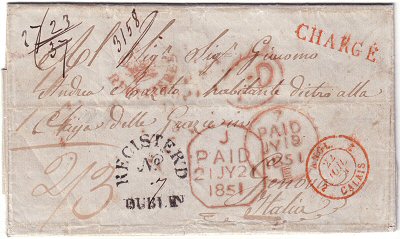Mail to/via France 1843-54
Instructions

This tool is for calculating paid rates to France, or to other countries via France, for the period during which the 1843 Anglo-French postal convention was in operation, 1st June 1843 to 31st December 1854. This is an important period where rates were simplified from what had come before, but still complicated relative to the rates that applied from 1st January 1855 under the 1854 Convention.
The total rate was the sum of the "British postage" and "French postage", based on multiples of a basic "British rate" and "French rate". For letters to France itself both were 5d, so the minimum rate was 10d (the rate the 10d embossed stamp was issued for). For letters via France the British rate was almost always the same, but the French rate was higher to account for the French agreements with the third country – e.g. initially 9d to Switzerland, later 6d.
The complications in calculating the total rate arise because the "progressive scales" were based on different principles. The British postage was calculated on the same principle as the inland scale of rates – i.e. up to ½oz = 1 rate, 1oz = 2 rates, 2oz = 4 rates, 3oz = 6 rates, and so on with each extra ounce or part of an ounce adding another 2 rates. The French postage was calculated on a simple quarter-ounce scale of one rate per ¼oz.
Postage due on unpaid/underpaid letters to/via France was calculated under the French system, which worked according to yet another different scale. As the British Post Office had no involvement in this process, these French rates are not covered here.
Registered letters add a further complication. They always had to be prepaid, and were subject to both British and French registration fees, which again were based on different principles. The British fee was flat rate, being the current inland fee – originally 1s, then from 28th March 1848 6d. The French registration fee was based on the French method of charging double postage as the price of registration, and so is equal to the French postage.
In some cases these rates were in force before or after this period, but these are not covered by this tool. Also, it was sometimes possible to pay only to the border of France, not all the way – rates were the same as to France.
There was one further difference that applied between the British and French systems – the British rates were for "up to" and the French rates were for "less than" the stated weight step. So for example a letter weighing exactly ½oz would still be charged at the basic British rate step for up to ½oz, but at the third French weight step for letters from ½oz to ¾oz. These "interstitial rates" are rare and are not included here, but are worth considering in the case of a cover that seems to have some otherwise inexplicable rate.
To use this tool, enter the appropriate amounts and the required number of quarter-ounce steps into the boxes above and click the "Calculate" button. The pre-entered defaults cover the rates to France and the British registration fee from 1848. Alternatively, data for a number of destinations is already available in the tool – select the country from the "Destination" drop-down and the date to calculate the rates for (many rates changed during the period, sometimes more than once).
(Note: the relevant British and French rates can be found from the invaluable book by Jane and Michael Moubray, British Letter Mail to Overseas Destinations 1840 to UPU.)
